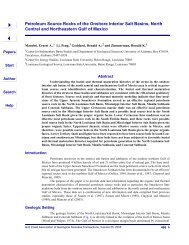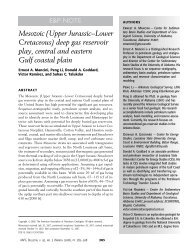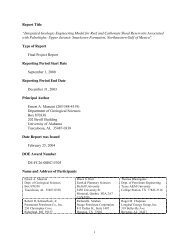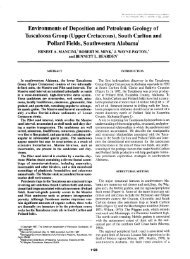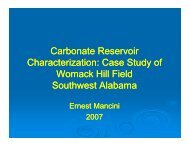Part 4 - Berg - Hughes Center
Part 4 - Berg - Hughes Center
Part 4 - Berg - Hughes Center
Create successful ePaper yourself
Turn your PDF publications into a flip-book with our unique Google optimized e-Paper software.
peripheral fault trend and numerous salt domes and anticlines. The regional peripheral<br />
fault trend consists of a series of en echelon extensional faults and half grabens that are<br />
associated with salt movement. Structural deformation related to salt movement was<br />
initiated probably during the Late Jurassic (Dobson and Buffler, 1997).<br />
Sedimentation in the northern Gulf of Mexico was associated with rifted<br />
continental margin tectonics. Syn-rift Triassic graben-fill red-beds of the Eagle Mills<br />
Formation were deposited locally as the oldest Mesozoic strata above pre-rift Paleozoic<br />
basement during the early stages of extension and rifting (Tolson et al., 1983; Dobson,<br />
1990).<br />
The syn-rift Middle Jurassic Werner Formation and Louann Salt are evaporite<br />
deposits that formed during the initial transgression of marine water into the Gulf of<br />
Mexico (Salvador, 1987). Basement structure influenced the distribution and thickness of<br />
Louann Salt, resulting in thick salt in the interior salt basins, and salt being absent over<br />
basement paleohighs (Wilson, 1975; Cagle and Khan 1983, Dobson, 1990; Dobson and<br />
Buffler, 1991). The updip limit of thick salt and the location of the extensional faults<br />
associated with the regional peripheral fault trend coincide with a basement hinge line<br />
and occur in the northern part of these salt basins and subbasins (Mancini and Benson,<br />
1980; Dobson, 1990; Dobson and Buffler, 1991).<br />
The distribution of the Late Jurassic post-rift deposits of the Norphlet, Smackover,<br />
Haynesville and Cotton Valley have been affected by basement paleotopography<br />
(Mancini and Benson, 1980; Dobson, 1990; Dobson and Buffler, 1991). The Norphlet<br />
Formation consists of alluvial fan and plain, fluvial and wadi, eolian sheet, dune and<br />
interdune and marine shoreface siliciclastic sediments (Mancini et al., 1985b; Dobson,<br />
434




